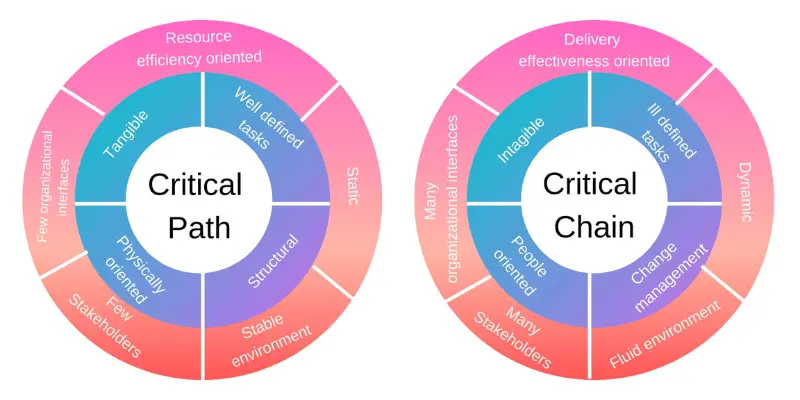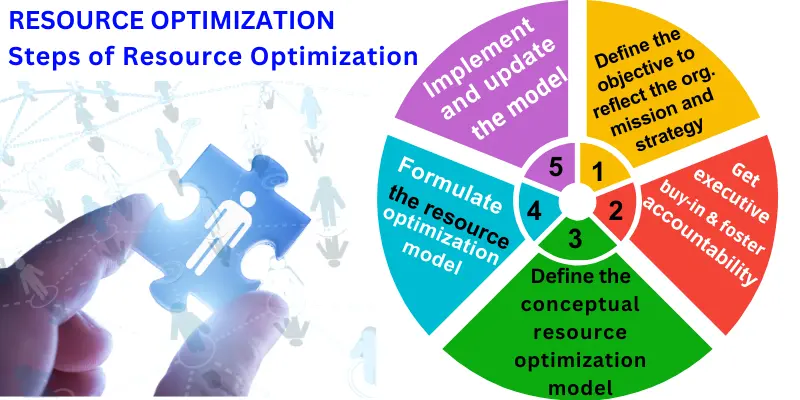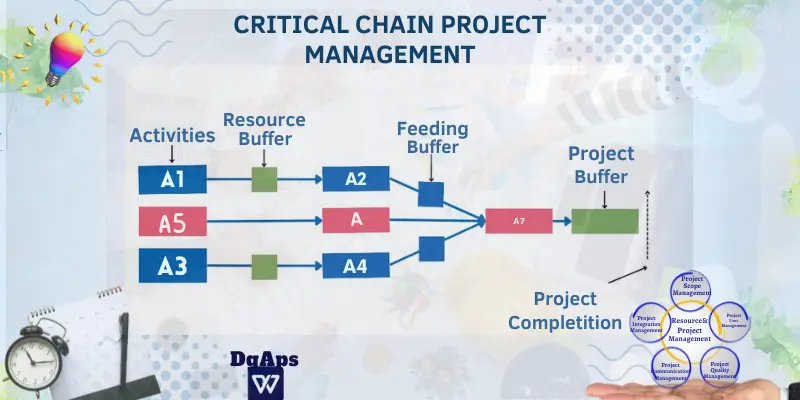Master Critical Chain Scheduling for On-Time Project Success
Published: 21 Nov 2025
Did you know that over half of plans fail because of poor scheduling? Critical Chain Project Scheduling (CCPS) can fix this by helping you use resources wisely and manage time better. Unlike older methods, CCPS adds extra time buffers to handle surprises. This ensures tasks are completed on time without issues. If you’re looking to improve results, CCPS could be the solution.
Tanveer, an expert in CCPS, shares tips from years of hands-on experience. This guide explains CCPS, how it works, and why it’s so effective. It also provides examples and tools to make starting easy.
By the end, you’ll have practical tips to make your projects and workflows more successful. Ready to plan smarter and finish your work smoothly? Let’s find out how CCPS can transform the way you manage.
What is Critical Chain Project Scheduling?
Managing projects can be challenging, especially when things aren’t planned. Critical Chain Project Scheduling (CCPS) helps us use resources wisely and flexibly. It adds extra time, called “buffers,” to deal with surprises. This keeps projects on track and helps everything run smoothly.
1. Definition and Key Principles
CCPS focuses on the “critical chain,” which is just the order of tasks based on what you have. Unlike older methods, CCPS looks at real-life problems and adds buffers to avoid delays. From what I’ve seen, this simple method helps tasks move forward without issues.
2. How Does It Differ from the Critical Path Method (CPM)?
CCPS and CPM are two different ways to manage projects. Here’s a simple comparison:
| Feature | Critical Chain (CCPS) | Critical Path (CPM) |
|---|---|---|
| Focus | Order tasks based on resources | Longest chain of tasks |
| Buffers | Adds extra time for delays | No extra time for delays |
| Flexibility | Easy to change if needed | It is more complicated to change once planned |
| Goal | Use resources wisely and finish on time | Track task deadlines |
CCPS reduces risks by adjusting to real-life challenges, while CPM follows strict timelines. The buffer system in CCPS works like a safeguard, ensuring steady progress even when problems arise.

Why Is Critical Chain Project Scheduling Important?
Have you ever felt like project deadlines are always just out of reach? I’ve been there. Projects often encounter roadblocks, such as resource shortages or unexpected delays, making it challenging to stay on track. That’s where Critical Chain Project Scheduling (CCPS) steps in. It focuses on managing resources smartly and adds flexibility to your plans, keeping everything under control. Think of it as your project’s safety net.
1. Common Project Scheduling Challenges
Managing a project can feel like juggling too many balls at once. Trust me, it’s frustrating when things don’t go as planned. Here are some challenges I’ve seen:
- Resource Constraints: Imagine trying to bake a cake with half the ingredients; you can’t do it. That’s what it’s like when a team lacks enough resources to complete tasks.
- Unrealistic Deadlines: Tight deadlines can feel like running a marathon without training; exhausting and often impossible.
- Task Dependencies: Have you ever had one domino fall and take the rest down with it? A delay in one task can disrupt the entire schedule.
| Where Are Time Buffers Typically Applied? |
|---|
I’ve learned that adding time buffers at critical points, like the end of the critical chain or near major milestones, can make a big difference. They act as a cushion, absorbing delays to keep the project on track. |
2. Benefits of Using CCPS
CCPS has been a game-changer for me and others I’ve worked with. It’s not just a method; it’s a practical way to improve project management. Here’s why it works so well:
- Reduced Delays: Unexpected issues? Buffers are there to handle them, keeping your timeline intact.
- Improved Resource Utilization: With CCPS, resources are placed where needed most, ensuring efficiency without waste.
- Better Collaboration: When everyone knows their role, teams work better together. CCPS brings that clarity.

Key Concepts in Critical Chain Project Scheduling
CCPS is a smart way to handle projects. It helps you stay organized and finish tasks on time. Let me show you how it works and why it’s helpful.
1. Project Buffers and Time Buffers
In CCPS, buffers are like extra time added to your schedule. They act like extra padding, helping you handle delays or unexpected problems.
- Imagine you’re on a road trip. You add extra time for breaks, traffic, or detours. This way, even if something unexpected happens, you’ll still reach your destination on time. Buffers in projects do the same thing; they keep your timeline safe.
- Plan where to place your buffers using tools like Gantt charts. This will make your schedule clearer and easier to manage.
2. Resource Optimization in CCPS
- CCPS prioritizes the most critical tasks and focuses on using your team and tools effectively.
- Think of a soccer game. The best players are given the most essential roles to help the team win. In the same way, CCPS ensures that the key people or tools are used for the most critical tasks.
- Check your resource plan often. This will help you spot problems early and fix them before they slow you down.

3. Why CCPS Works for Me
I love CCPS because it keeps my projects on track and reduces stress. Adding buffers and focusing on the most critical tasks, I avoid last-minute chaos and achieve better results.
Think of CCPS like cooking. When all the ingredients are ready, cooking becomes much easier and faster. The same idea applies to projects; prep first, and everything flows smoothly.
Steps to Implement Critical Chain Project Scheduling
It helps you manage tasks better, making things easier, faster, and less stressful. Follow these simple steps to get started and see great results.
1. Step-by-Step Guide to Adopting CCPS
CCPS might initially seem complex, but breaking it down into small, precise steps can simplify the process. Here’s how I do it:
- Define the Project Scope: First, decide what your project is about. Write down what you want to achieve, what you need to deliver, and when it should be done. This is like planning your day—knowing what to do makes things easier.
- Identify the Critical Chain: Focus on the most important tasks to finish your project. These tasks will determine the duration of your project.
- Strategically add buffers: Add a little extra time, called buffers, to your plan. This additional time helps you deal with unexpected problems, like delays. It’s like leaving early for school in case there’s traffic; you’ll still be on time.
- Optimize Resource Allocation: Make sure everyone and everything in your project is used well. Don’t let people work on too many things simultaneously; it slows them down. Focus on one task at a time for better results.
- Monitor and Control Progress: Monitor the project’s progress. Use simple tools to track time and resources. Checking often helps you fix problems quickly.
2. Tools and Techniques
To make CCPS even more manageable, here are some tools that can assist:
- Asana: This tool enables you to keep track of tasks and work together as a team. For additional insights, explore Asana’s guide on project management methodologies.
- Smartsheet: It’s great for making plans and timelines. It’s easy to see how things are going.
- Microsoft Project: A good tool for big projects. You can track tasks, resources, and deadlines.
Pick one tool that you like and start with that. Simple tools can make a big difference.
The way to get started is to quit talking and begin doing. Walt Disney
3. A Simple Example
Imagine you’re going on a family trip. First, you plan where and how to get there (project goals). Then, you find the essential stops on the way (important tasks). You add extra time for traffic or breaks (buffers). Finally, you use a map or GPS to stay on track (tools). That’s how CCPS works!
Taking small, clear steps and using the right tools makes projects more straightforward. This method has helped me a lot and can help you, too.
Advanced Insights on CCPS
CCPS is a savvy method for managing undertakings that continue to prove useful. It permits teams to use their time and resources better and stay on track, even when things change suddenly. Let’s discuss how CCPS works in flexible projects like agile ones and share a success story about how it made a real difference.
1. Critical Chain Project Scheduling in Modern Agile Projects
Speed and teamwork are crucial in agile projects. CCPS provides structure, like a solid base under a shaky bridge, ensuring agile teams stay organized and finish tasks on time.
Here’s how CCPS solves common problems:
- Fewer Distractions: It prevents team members from doing too many things at once, allowing them to focus on one task at a time.
- Extra Time for Surprises: CCPS adds small “time cushions” that help if something unexpected happens, so projects are not delayed.
Suppose you’re juggling three balls, and someone gives you a fourth one. You’ll probably drop all the balls, right? CCPS takes away the extra ball so you can juggle without messing up.
2. Success Story: Digital Applications
Let’s look at Digital Applications, a company that makes apps and websites, improves websites (SEO), and does online marketing (Visit Website). The company had trouble finishing its projects on time because its team did too many things simultaneously.
Here’s how CCPS helped them:
- Focused on What Matters: They identified and prioritized the most critical tasks.
- Added Time for Feedback: They included extra time to handle client feedback, preventing delays.
- Minimized Task Switching: The team focused on one task at a time instead of jumping between many tasks.
- What Happened Next? They started finishing 30% more projects on time in six months, and their clients were much happier.

3. Why CCPS Is Awesome
CCPS and Agile make a perfect team. Agile helps with teamwork and quick changes, while CCPS keeps everything on track. Together, they ensure projects finish on time, even when resources are limited or things don’t go as planned.
What can you do? Try CCPS for your projects and see how it can make your work easier, faster, and more successful.
| A Personal Message from Me |
|---|
CCPS is like a guide that allows teams to handle challenging projects easily. By sharing this story and tips, I hope you’ll feel confident trying it out and seeing great results. |
Overcoming Challenges in Critical Chain Project Scheduling
Starting with Critical Chain Project Scheduling (CCPS) can feel overwhelming, but with the proper steps, it gets easier. Change isn’t always easy, but I’m here to guide you through common problems and practical solutions.
1. Identifying Common Barriers
- Managing Resources: When resources are overbooked or unavailable, projects slow down. This creates delays and affects essential tasks.
- Resistance to Change: Switching to CCPS means new ways of working, which some team members might find difficult. This resistance can hold back progress.
2. Strategies for Successful Implementation
- Train and Support Your Team: Teach your team how CCPS works and how it helps. Use workshops and examples to show how it reduces multitasking and makes work easier.
- Think of it as a to-do list: It prioritizes tasks and keeps everything on track.
- Check Buffers Regularly: Buffers act as a safety net for delays but need regular attention. Adjust them as your project changes to keep everything running smoothly.
- Imagine buffers as plants in a garden: They need care to grow and stay healthy.

3. Your Road to Success
Tackling these challenges will make your projects more efficient. By managing resources, training your team, and maintaining buffers, CCPS will soon feel like a valuable tool.
Change takes effort, but each step gets you closer to success. Stick with it, and you’ll see how much smoother and less stressful your projects become.
| Interesting Fact |
|---|
|
Conclusion
Critical Chain Project Scheduling (CCPS) helps you use resources wisely and adds extra time to handle surprises, ensuring your projects finish on time. Unlike older methods, CCPS adapts to changes and keeps things running smoothly, even when unexpected challenges arise.
In my experience, using CCPS has significantly improved project outcomes. By prioritizing tasks and managing time efficiently, teams can reduce stress and improve performance.
If you want to enhance your project management skills, I highly recommend trying CCPS. Ready to see how it can transform your projects? Give it a shot and experience the improvement firsthand.
| Summary |
|---|
|
CPPS FAQs
Here are simple answers to common questions about Critical Chain Project Scheduling (CCPS) to help you understand and apply it effectively.
Critical Chain Project Management (CCPM) focuses on identifying the most essential tasks in a project (the critical chain) and managing resources to ensure timely completion. It integrates time buffers to mitigate risks and ensure smooth project flow.
- The Critical Path Method (CPM) focuses on finding the most extended task sequence that affects the project’s timeline.
- The Critical Chain Method (CCPS) adds resource management and time buffers to handle delays.
- Think of CPM as planning the route and CCPS as adding safety cushions to the journey.
Time buffers act as extra time added at key points in the schedule to handle unexpected delays.
For example, like adding 30 minutes to a road trip plan for traffic, buffers ensure smooth project progress even with surprises.
- Asana: Helps prioritize tasks and visualize workflows.
- Smartsheet: Tracks timelines and buffer usage.
- ProChain: Designed for CCPS with tools for managing buffers and resources.
- Test these tools to find what works best for your team!
| References Sources |
|---|
Foundational Principles of Critical Chain
|

- Be Respectful
- Stay Relevant
- Stay Positive
- True Feedback
- Encourage Discussion
- Avoid Spamming
- No Fake News
- Don't Copy-Paste
- No Personal Attacks

- Be Respectful
- Stay Relevant
- Stay Positive
- True Feedback
- Encourage Discussion
- Avoid Spamming
- No Fake News
- Don't Copy-Paste
- No Personal Attacks







